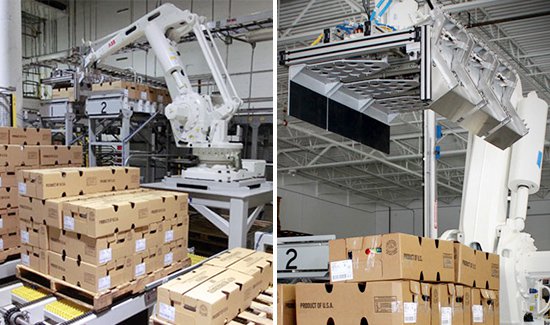
The Intangible Benefits of Used Equipment
Mark Colzani | 17 January 2013
Used automation equipment is seen by some as too risky an investment, and by others, as an easy way to save a project's budget while still getting all of the hardware they desire. Like all projects, there are pros and cons to used or refurbished equipment; and when the opportunity for used automation presents itself, it is worth the time to closely examine refurbished options against shiny new automation to maximize the bang for your buck. At this very moment, I am in the northeast starting up a large automated palletizing cell composed entirely of used equipment from a variety of manufacturers and am witnessing firsthand the benefits of used automation that can't be represented in a pocketbook.
Evaluating Used Equipment
1. Physical Evaluation - When evaluating "pre-loved" equipment for purchase, it is wise to start at the source of this equipment--the original manufacturer. To ensure the equipment will run efficiently and be flexible to your needs for the foreseeable future, you'll want to make sure the original manufacturer still has on record any programs, drawings, spare parts lists, specifications, and service records for the equipment. Having access to all of these things has allowed me to assist in many system start-ups with alarming efficiency. Someone else has already done the work to start the equipment once, so it would be silly to not gain from their knowledge and be a step ahead of the game. If access to this information isn't readily available, it is likely you will be in for a much longer start-up than necessary while programmers dig through code and any worn or broken parts have to be redesigned and fabricated from scratch.
2. Financial Evaluation - Access to equipment histories and revised bills of materials can allow a financial evaluation of the equipment. You can quickly establish necessary maintenance intervals and associated costs as well as costs of a spare parts inventory. Equipment histories and bills of materials also help you quickly define any necessary changes you’ll need to meet your specific company or industry standard.
3. Standards Evaluation - Another very important question to ask the OEM is about their engineering and manufacturing standards. I was in elementary school when some of the automation I've worked on was being manufactured, but sound and flexible standards in engineering design mean I don't have to spend any of my customer's time re-inventing the wheel. I can plug into a processor that no engineer has even thought about for a decade, and in minutes, successfully troubleshoot any issues that might have come up during relocation of the equipment because the standards put in place many moons ago are still used with great success today.
Getting the Most Out of Your “New” Equipment
Once you've decided to take on the opportunity of used equipment, there are some very important intangible benefits a company can use to their advantage during the transport and start-up period. Most of the used equipment I've worked with was purchased by relatively small companies new to large scale automation or by a small, young group within a larger company. In these instances, the equipment can be used to transition into automation at a greater pace than if the same company or team had purchased a turn-key automated solution.
With new custom equipment, the common practice is to go through a series of design reviews where the customer will get the largest benefit already having an automation expert to critique and evaluate the solutions. With used equipment, this process was already done, and the solution has been put to the test. This allows young engineers and technicians to familiarize themselves with only one iteration of a solution, the iteration that is going to get the job done for them. This also relieves the pressure of accepting designs and standards that a young engineer might not have the confidence to say will or will not work for them.
Since there is no design or manufacturing involved, it is always a good idea to appoint an internal "system expert" to learn the ins and outs of the equipment. This prevents long and expensive service trips from vendors, and generates confidence internally that any issues with the equipment can be dealt with immediately. A short service trip from the OEM can then be used to assist in start-up and to fill in any blanks that the system expert may have, including training in safe operation of the equipment.
Remember, we bought equipment that was and will be supported throughout its lifetime by the OEM, so any questions or issues are never more than a phone call away! When done properly the end result is a quick and efficient start-up of re-purposed equipment, the training of one or more system experts before the first products roll down the line, and an internal sense of accomplishment and confidence in a smooth, hands-free operation for many years to come.
If you have questions about implementing used equipment in your facility or need help completing the project, please contact us. We're happy to assist.
Comments
No comments have been posted to this Blog Post
Leave a Reply
Your email address will not be published.
Comment
Thank you for your comment.